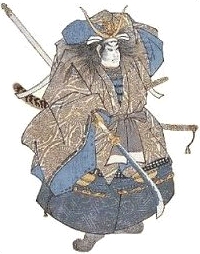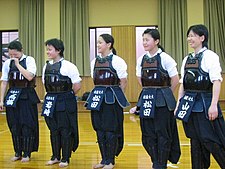Naginata

Naginata (なぎなた, 薙刀) is a pole weapon that was traditionally used in Japan by members of the samurai class. It has become associated with women and in modern Japan it is studied by women more than men; whereas in Europe and Australia naginata is practiced predominantly (but not exclusively) by men. A naginata consists of a wood shaft with a curved blade on the end; it is similar to the Chinese Guan Dao or European glaive. Usually it also had a sword-like guard (tsuba) between the blade and shaft.
The martial art of wielding the naginata is called naginatajutsu. Most naginata practice today is in a modernised form, a gendai budō called atarashii naginata ("new naginata"), in which competitions also are held. Use of the naginata is also taught within the Bujinkan and in some koryū schools. Naginata practitioners may wear a modified form of the protective armour worn by kendō practitioners, known as bōgu.
History
The term naginata first appeared in the Kojiki in 712 CE and was used by Sohei warrior priests during the Nara Period, around 750 AD. It is most likely based off of the Chinese Guan Dao. In the paintings of battlefield scenes made during the Tengyo no Ran in 936 CE, the naginata can be seen in use. It was in 1086, in the book Ōshū Gosannenki ("A Diary of Three Years in Ōshū") that the use of the naginata in combat is first recorded. In this period the naginata was regarded as an extremely effective weapon by warriors.
During the Gempei War (1180-1185), in which the Taira clan was pitted against Minamoto no Yoritomo of the Minamoto clan, the naginata rose to a position of particularly high esteem. Cavalry battles had become more important by this time, and the naginata proved excellent at dismounting cavalry and disabling riders. The widespread adoption of the naginata as a battlefield weapon forced the introduction of sune-ate (shin guards) as a part of Japanese armor. The rise of importance for the naginata can be seen as being mirrored by the European pike, another long pole weapon employed against mounted warriors. An excellent example of the role of women in Japanese society and martial culture at this time is Itagaki, who, famous for her naginata skills, led the garrison of 3,000 warriors stationed at Toeizakayama castle. Ten thousand Hōjō clan warriors were dispatched to take the castle, and Itagaki led her troops out of the castle, killing a significant number of the attackers before being overpowered.

During the Edo Period, as the naginata became less useful for men on the battlefield, it became a symbol of the social status of women of the samurai class. A functional naginata was often a traditional part of a samurai daughter's dowry. Although they did not typically fight as normal soldiers, women of the samurai class were expected to be capable of defending their homes while their husbands were away at war. The naginata was considered one of the weapons most suitable for women, as it allows a woman to keep a male opponent at a distance, where his greater height, weight, and upper body strength offers less of an advantage.
By the 17th century the rise in popularity of firearms caused a great decrease in the appearance of the naginata on the battlefield. However, the naginata saw its final uses in combat in 1868, at Aizu, and in 1876, in Satsuma. In both cases it was used by fighting women.
Due to the influence of Westernization after the Meiji Restoration the perceived value of martial arts, the naginata included, dropped severely. It was from this time that the focus of training became the strengthening of the will and the forging of the mind and body. During the Showa period, naginata training became a part of the public school system.
Martial arts training in Japan was banned for five years by the Allied Forces after Japan's surrender at the end of World War II. After the lifting of the ban in 1950, a modern form of naginata training, known as Atarashii naginata ("new naginata"), was developed. Since World War II, naginata has primarily been practiced as a sport with a particular emphasis on etiquette and discipline, rather than as military training.
Construction
The naginata, like many weapons, can be customized to fit the build of the bearer. Generally, the naginata shaft is the height of the bearer's body, with the blade mounted atop usually measuring two or three shaku (one shaku is equivalent to 11.93 inches, or 303 mm) long. Unlike most polearms, the shaft is oval in cross section to allow easy orientation of the blade, and ranges from 5 to 7 feet (1.5 to 2.1 meters) long. The blade is usually curved, sometimes strongly so, towards the tip. As with Japanese swords, naginata blades were forged blades, made with differing degrees of hardness on the spine and edge to retain a sharp edge but also be able to absorb the stress of impact. Some naginata blades may, in fact, have been recycled katana blades.
Note also at the opposite end of a naginata, the ishizuki, (a metal end-cap, often spiked, which functioned as a counterweight to the blade) was attached, rendering the naginata an effective weapon whichever end was put forward.
In contemporary naginatajutsu, there are two general constructions. The first, the kihon yo, is carved from one piece of Japanese white oak and is used for the practice of katas (forms). This is quite light, and may or may not feature the tsuba between the blade and shaft sections. The second type, the shiai yo, uses a similar wooden shaft, but the blade is constructed from bamboo and is replaceable as it can break through hard contact. This type is used in atarashii naginata, the bamboo blade being a lot more forgiving on the target than a wooden or metal blade.
Many of the imitation "naginata" for sale to the public are not actually naginata at all, as may be concluded from the above details on proper construction. Specifically, these imitations have shorter, rounded shafts, very short blades, and screw-together sections.
Usage

Naginata can be used to stab, but due to their relatively balanced center of mass, are often spun and turned to proscribe a large radius of reach. The curved blade makes for an effective tool for cutting due to the increased length of cutting surface. In the hands of a skilled practitioner, one 5-foot (1.5 m) tall wielder could conceivably cover and attack in 380 square feet (35 m²) of open, level ground with a 5 foot (1.5 m) shaft, 3 foot (1 m) blade, 3 foot (1 m) reach. Naginatas were often used by foot soldiers to create space on the battlefield. They have several situational advantages over a sword. Their reach was longer, allowing the wielder to keep out of reach of his opponent. The long shaft offered it more leverage in comparison to the hilt of the katana, enabling the naginata to cut more efficiently. The weight of the weapon gave power to strikes and cuts, even though the weight of the weapon is usually thought of as a disadvantage. The weight at the end of the shaft and the shaft itself can be used both offensively and defensively. Swords, on the other hand, can be used to attack faster, have longer cutting edges (and therefore more striking surface and less area to grab), and were able to be more precisely controlled in the hands of an experienced swordsman.
Famous users
See also
External links
- Japan Naginata Union
- US Naginata Federation home page and general information
- British Naginata Association
- Naginata Association of Western Australia
- Southern California Naginata Federation - history of the naginata
- Canadian Naginata Federation home page
- Template:Pt icon Brazilian Naginata Association
